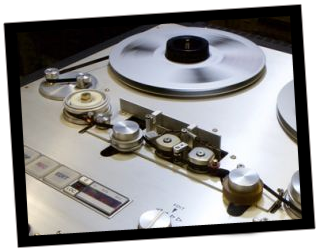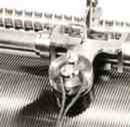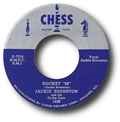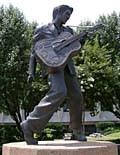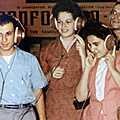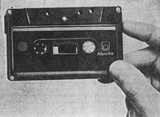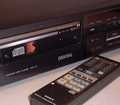
Magnetic Tape Recording Invented
Telegraphone from Magnetic Recording Pictures |
Webster wire recorder |
1928 - Dr. Fritz Pfleumer patent in Germany for application of magnetic powders to strip of paper or film.
1931 - Pfleumer and AEG begin to construct the first magnetic tape recorders.
1932 - BASF of I.G. Farben joined with AEG of Telefunken to develop magnetic tape recording using Pfleumer patent; by 1934, BASF is able to manufacture reels of plastic-based tape.
1935 - first public demonstration of BASF/AEG "Magnetophone" at Berlin Radio Fair.
1936 - first BASF/AEG tape recording on Nov.19 of live concert by Sir Thomas Beecham.
1939 - independent invention of the wire recorder in U.S. by Marvin Camras at Armour Research Foundation and sold to military during World War II; wire recorders such as the Webster pictured at right were popular with amateurs until the late 1950s.
1940 - David Sarnoff of RCA installed first secret recording devices in the White House for 11 weeks, from June to October, using the same optical Phonofilm method used in RKO films.
1941 - The quality of the Magnetophone in Germany dramatically improved with the use of high frequency biasing developed by Weber and Von Braunmuhl at AEG.
1944 - 3M Co. (Minnesota Mining and Manufacturing) began tape coating experiments in U.S. under Ralph J. Oace.
Tape Recording Comes to America
1945 - Signal Corps Captain John Mullin found Magnetophones at Radio Frankfurt in Germany and 1000-meter reels of 6.5mm ferric-coated BASF tape with 20-min capacity; he mailed 2 machines to U.S. with 50 reels of tape, and after the war worked on them to improve the electronics.
Crosby with early Ampex home model ca. 1948, from Ampex Corp. |
one of the first RCA 45 rpm players, from the Smithsonian |
|
Rock-Ola 120-selection coin wall box found in taverns and diners |
Rocket 88 label from |
Elvis statue on Beale Street in Memphis |
Soundmirror tape recorder by the Brush Development Co. |
1946 - Mullin demonstrated Magnetophones at San Francisco Institute of Radio Engineers on May 16, and Harold Lindsay told Ampex boss Alexander M. Poniatoff who began work on developing a U.S.-made magnetic tape recorder.
1947 - Mullin demonstrated Magnetophones to Bing Crosby Enterprises in June. NBC had refused to record his show, Bing moved to ABC with Philco sponsor in the fall, brought with him Mullin's Magnetophones to tape his new season shows and dub to 16-inch transcription disc for broadcast starting Oct. 1 - see Der Bingle Technology article on Bing Crosby.
1948 - 1st U.S.-made Ampex Model 200 tape recorders arrived for Crosby show #27 along with 3M Scotch 111 gamma ferric oxide coated acetate tape.
1948 - Columbia introduced on June 21 the first 12-inch 33-1/3 rpm micro-groove LP vinylite record with 23-minute per side capacity, developed by Peter Goldmark in 1947, using players made by Philco.
1949 - RCA Victor introduced 7-inch 45 rpm micro-groove "Extended Play" vinylite record and player; article from RCA Review,later records made of polystyrene. In September, Capitol became the first major label to support all three recording speeds of 78, 45, 33-1/3 rpm.
1951 - war of the speeds ended as Victor sold LPs and Columbia sold 45s.
1947 - Big 6 record companies controlled majority industry: Columbia, Victor, Decca, Capitol, MGM, Mercury; but teenagers rejected majority music style, giving opportunity to the rise of new small independent labels.
1947 - Roy Brown recorded one of the earliest "rock and roll" songs Good Rocking Tonight on DeLuxe label, although the name was common in early blues recordings such as Trixie Smith's 1922 My Man Rocks Me With One Steady Roll.
1949 - Todd Storz of Omaha's KOWH created Top 40 after observing customers in a bar play the same juke box selection over and over.
1950 - Muddy Waters recorded Rollin' Stone for the Aristocrat label of Leonard and Phil Chess on Maxwell Street in Chicago, at the end of Highway 61, "the road to freedom" followed by many black blues singers from the Miss. Delta to Chicago. Waters electrified the blues and helped create rock and roll.
1951- Sam Phillips in his studio in Memphis used his Ampex 350 tape machine to record Rocket 88, written by Ike Turner, sung by Jackie Brenston, and sold to Leonard and Phil Chess in Chicago who released it as the 78 rpm Chess record #1458. The sale of this master tape allowed Phillips to start his own Sun Records label.
1952 - Alan Freed started Moondog's Rock and Roll Party in Cleveland after visit to Leo Mintz's record store.
1953 - Elvis Presley in the summer made his first recording (a personal disc for himself, not for his mother's birthday that was in the spring) at the Sun studio of Sam Phillips in Memphis; the second recording by Elvis at Sun was That's All Right released July 19, 1954, taped on the two Ampex 350 recorders Phillips used to create the "slapback" audio delay that became a trademark sound of Sun records.
1954 - Bill Haley recorded rhythmic Shake, Rattle and Roll and Rock Around the Clock on Decca, due to the success in 1953 of his first national rock hit Crazy Man Crazy on Essex label.
1955 - Sam Phillips on Nov. 10 sold his recording contract with Elvis to RCA and Colonel Tom Parker for $35,000.
1956 - Elvis Presley recorded Heartbreak Hotel on January 10 in Nashville at his first session for RCA in the RCA Studio on 1525 McGavock Street, and A Big Hunk o' Love June 10, 1958, in the new Studio B on Music Row. According to the Elvis Presley Studio Recordings RCA erased most of its tapes from the 1950s for later reuse, but a good transfer of the original, spliced A Big Hunk o' Love master can be found on the CD "All Time Greatest Hits", PD90100(2)
1945 - Paul Klipsch patented the Klipschorn folded horn speaker. The innovations in speakers and amplifiers and tape recorders after World War II contributed to the birth of a"Hi Fi" era that produced stereo and transistor radios and cassette tape players.
1949 - Magnecord added a 2nd head to its PT-6 tape recorder (the mono model was first introduced at the May 1948 NAB show) to create one of the first open reel stereo tape recorders; see tape recorder ads. Willi Studer in Herisau, Switzerland, made his first Dynavox tape recorder that evolved into the Revox A36 by 1953, and after moving to a new factory in Regensdorf near Zurich in 1960, began to produce the 2 and 4-track Revox D36.
1949 - Frank H. McIntosh and Gordon J. Gow sold the first McIntosh 50W1 Unity Coupled Amplifier, producing 50 watts at less than 1% distortion from 20 Hz to 20,000Hz.
1951 - Stefan Kudelski in Switzerland built the first Nagra portable, self-contained tape recorder with wind-up motor, and Max Grundig in Germany introduced the Reporter tape recorder.
1954 - Acoustic Research introduced the small AR-1 bookshelf loudspeaker that used the acoustic suspension principle developed by company co-founders Edgar Villchur and Henry Kloss. This was soon followed by the $89 AR-2 and by the AR-3 with improved domed tweeters in 1958.
1954 - RCA Victor sold the first prerecorded open reel stereo tapes for $12.95.
1954 - Regency TR-1, first transistor portable radio introduced by I.D.E.A. Co. of Indianapolis - see note on the
Chrysler Imperial 1956, from the Imperial Home Page) |
question of who made the first such radio.
1956 - The Chrysler Imperial 16-2/3 rpm record player with 7-inch ultramicrogroove records developed by Peter Goldmark.
1957 - May 28 the National Academy of Recording Arts & Sciences was founded in Hollywood by Paul Weston of Columbia, Lloyd Dunn of Capitol, Sonny Burke of Decca, Jesse Kaye of MGM and Henri Rene and Dennis Farnon of RCA Victor, with Jim Conkling of Columbia as its first president, and began to grant the annual Grammy Awards in 1959 for the best recordings and performers of 1958. Tom Stockham received the first Technical Grammy Award in 1994.
1958 - world standard for stereo records established, and first stereo LPs sold; new generation of Hi-Fi components adopt stereo. Koss introduced stereo headphones.
stereo 'phones 1958, from Koss Museum |
1959 - Seeburg sold the "Background Music System" with 16-2/3 rpm records.
1962 - Henry Kloss introduced the KLH Model 11 portable stereo, the first transistorized record player, with the changer/amplifier and two speakers folding into a three-piece suitcase. Kloss had left his previous partner Edgar Villchur at Acoustic Research and founded KLH in 1957 with Malcolm Low and J. Anton Hofmann.
1963 - Philips demonstrated its first compact audio cassette using high-quality BASF polyester 1/8-inch tape that ran at 1-7/8 ips; sold the next year in the U.S. with the Norelco Carry-Corder dictation machine, but the demand for blank tape used for personal music recording was unanticipated by Philips.
1966 - U.S. cars equipped with 8-track stereo cartridge tape players developed by William Lear (who founded the Learjet aviation company in 1962), Ampex, and RCA.
1969 - Dolby Noise Reduction introduced for pre-recorded tapes.
first Ampex video tape recorder, 1956, from History of Television |
1950 - "Jack Mullin, then Bing Crosby's recordist and chief engineer, began working at the newly established electronics division of Crosby Enterprises to develop a magnetic TV recorder" - from Tape Recorder History by Jerry Whitaker.
1951 - Ampex team led by Charles Ginsburg began work on a video tape recorder (VTR) in October; Bing Crosby Enterprises demonstrated an experimental 12-head VTR at 100 ips.
1953 - Vladimir K. Zworykin and RCA Labs demonstrated Dec. 1 a longitudinal VTR running very fast at 360 ips over 3 heads with AM sound.
1956 - Ampex demonstrated first practical quadraplex VTR at Chicago NAB show April 14, using 2-inch wide 3M tape at 15 ips over rotating head assembly recording at a slant on tape surface with AM sound; over next 4 years sold 600 units at $75,000 each, mostly to big network stations.
1956 - CBS broadcast the first network television show with videotape Nov. 30, Douglas Edwards and the News, for West Coast delayed broadcast.
1957 - Ampex and RCA pooled patents to develop compatible color and B&W VTR.
1959 - first mobile Ampex VTR unit.
Japanese Introduce Helical Scan
1959 - Toshiba in September demonstrated prototype helical scan model VTR-1, with 2-inch tape running at 15 ips over just one head. After the demonstration, Sony began to develop the helical scan VTR.
1960 - Ampex shared VTR patents with Sony and Sony shared transistorized circuitry with Ampex.
1961 - JVC (founded as the American-owned Victor Co. of Japan in 1946, but owned by Matsushita since 1953) demonstrated helical scan color VTR with 2 heads.
1961 - Sony marketed helical scan VTR, the PV100, adopted by American Airlines in 1964 for in-flight movies; Ampex sued Sony in 1966.
1963 - Sony marketed first home VTR for $995, open reel 1/2-inch helical scan deck.
1964 - Ampex joined with Toshiba to market U.S.-designed VTRs in Japan.
1965 - Sony introduced first consumer 1/2-inch format helical scan VTR and priced under $3000. Philips introduced the compact cassette for consumer audio recording and playback on small portable machines such as the Norelco Carry-Corder 150.
1967 - In March, the Ampex HS-100 color video magnetic disc recorder is used for rapid playback in normal, slow, or stop action, at the ABC "World Series of Skiing" in Vail, Colorado, marking the beginning of "instant replay" on commercial television.
1968 - CBS introduced EVR using film in a cassette; 20th Century Fox agreed to sell movies in EVR; but the format faced growing competition by 1972 from videocassette formats introduced by RCA, Sony, Ampex and Avco, all seeking to develop a new consumer market for home VCRs.
1969 - RCA demonstrated SelectaVision that played pre-recorded cassettes but did not record.
1969 - Sony introduced first videocassette, the 3/4-inch U-Matic one-hour tape, available in U.S. by 1971. For the first time, Sony allowed other manufacturers to sell machines that could play the cassette, and thus succeeded in establishing a world standard for the 3/4-inch videocassette.
1970 - Ampex introduced the Instavision that it had developed with Toshiba; N.V. Philips introduced its own videocassette recorder (VCR) format in Europe; AVCO introduced a solid state compact Cartrivision VCR.
1972 - Phillips demonstrated a laserdisc playback-only deck.
1972 - Sears and Wards sold CartriVision, but too many competing VCR formats caused all to fail by 1973.
1975 - Sony introduced in November in the U.S. the Betamax consumer VCR (console only) for $2295 with one-hour 1/2-inch tape cassettes for $15.95. Sony sought to created a standardized format, as it had done with the U-matic in 1969, by getting 7 other companies to agree to produce machines that would play the Beta cassettes.
1976 - JVC introduced in October in Japan the VHS format VCR for $885.
1976 - Sony introduced a Betamax VCR deck for $1300 and began aggressive advertising claiming that it "can actually videotape something off one channel while you're watching another channel" and "build a library of your favorite shows." MCA/Universal and Disney filed lawsuit finally won by Sony in 1984.
1977 - RCA announced in March it would sell VHS with 4-hour tapes.
1978 - Pioneer developed the LaserDisc that was first used by General Motors to train Cadillac salesmen. Pioneer began selling home LaserDisc players in 1980.
1979 - Sony introduced Betascan in April that allowed visible picture while fast-forwarding.
1979 - Sony introduced the TPS-L2 Walkman portable audio cassette player, inaugurating a new era of personal music listening; the Sony family of portable personal music players would grow to include over 500 models, from the original pocket-sized 14-oz Walkman to the D-88 Pocket DiscMan of 1988 to the DAT Walkman TCD-D3 of 1991 to the MiniDisc of 1992 to the digital Discman of 1999. According to Sony's press release, in the 20-year history of the Walkman devices, 100 million units were sold in the U.S. creating a $1 billion industry. By 1983, more pre-recorded audio cassettes (236 million) were sold than LPs, a decline in the big vinyl discs that was accelerated in the 1980s by the compact disc digital revolution.
1980 - Sony introduced first consumer video camcorder.
1983 - Sony introduced the Beta HiFi VCR with high-quality FM sound.
1985 - Sony introduced the 8-mm format in April; the VHS group, led by JVC, brought out a compact version of VHS, known as VHS-C, but it only recorded for 20 minutes.
1988 - Super-VHS video format equalled 8-mm in picture quality but not in sound quality.
1989 - Sony introduced the Hi8 video format and the Sony CCD-V99 camcorder.
Digital Revolution - see topics
1982 - first digital audio 5-inch CD discs marketed, merging the consumer music industry with the computer revolution
1985 - Sony and Philips produced the standard for Compact Disc Read Only Memory (CD-ROM) computer discs that would use the same laser technology as the audio CD.
1987 - Digital Audio Tape (DAT) players introduced
1988 - for the first time, CD sales surpassed LP sales, leaving CD and cassette as the two dominant consumer formats; more than 1/2 of TV households own a VCR; the first transatlantic fiber-optic cable carried up to 37,000 telephone transmissions and began to replace satellites for telephone communication.
1990 - Canada began digital radio that used the L-band.
1993 - Digital HDTV Grand Alliance in October selected Dolby AC-3 to provide digital surround sound for the emerging technology of digital television.
1994 - Global Big 6 control $30 billion record industry: Philips (owns Polygram, A&M, Mercury, Island), Sony (owns CBS Records), Matsushita (owns MCA, Geffen), Thorn-EMI (owns Capitol, Virgin), Time Warner, and Bertelsmann (owns RCA Records)
1995 - By September, all companies in the DVD consortium agreed to DVD standards.
1996 - DVD players started selling in Japan, and began in 1997 selling in the U.S.
1997 - San Diego's MP3.com was founded in November by Michael Robertson; Another digital pioneer company was founded in San Diego in August 1998, Packetvideo, that became a leader in cell phone mobilemedia.
1998 - Jonell Polansky produced the first 24-bit 48-track digital recording session at Ocean Way on Nashville's Music Row
1998 - Aug. 6 the first HDTV set went on sale for $5,499 to the public in San Diego, a 56-inch Panasonic set that was developed at the company's research and development center in San Diego and manufactured in Tijuana.
1998 - The Last Broadcast premiered Oct. 19 as "the first desktop feature film" produced and exhibited digitally, co-sponsored by Texas Instruments using its DLP digital cinema projector.
1999 - TiVo and Philips announced March 31 in a press release shipments of "the first personal TV system."
The 5 largest record companies in the U.S. controlled 84% of the 755 million albums sold in the U.S. in 1999: 26.3% by Seagram's Universal (owns MCA, Polygram), 16.2% by Sony Music (owns Columbia), 16% by Bertelsmann's BMG (owns RCA Victor), 15.7% by Time Warner's Warner Music, 9.4% by EMI.
2000 - Disney released on Jan. 1 Fantasia/2000 in the IMAX film format with 6-channel digital sound.
2001 - Apple Computer introduced on Oct. 23 the iPod portable music player.
2002 - Annual world production of DVD-Video discs surpassed VHS cassettes, according to IRMA industry statistics: DVD increased from 1.08 billion in 2001 to 1.74 billion in 2002; VHS declined from 1.533 billion in 2001 to 1.33 billion in 2002.
2003 - DVD-Video rentals increased 51.2% and VHS rentals dropped 29% from the previous year; DVD-Video sales increased 42.2% to $12.1 billion and VHS sales dropped 34.8% to $2.4 billion, according to Video Store Magazine.
2004 - The first HD car radio was sold Jan. 5 in Cedar Rapids, Iowa, according to the iBiquity Digital Corp. press release, "the biggest revolution in radio since the advent of FM broadcasting more than fifty years ago."
2005 - Apple introduced on Jan. 11 the iPod Shuffle solid-state music player.




